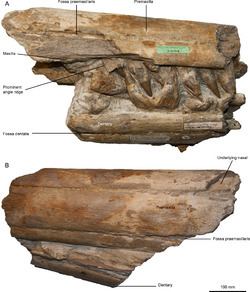Phylum Chordata Order Ichthyosaur | Class Sauropsida Rank Genus | |
 | ||
Similar Ichthyosaur, Platypterygius, Brachypterygius, Ophthalmosauridae, Campylodoniscus | ||
Pervushovisaurus is a genus of platypterygiine ichthyosaur from the Late Cretaceous (Cenomanian, 94-100 Ma) of the Saratov region in western Russia and the Cambridge area of the UK. It was originally described as a subgenus of Platypterygius, but later work showed that it was distinct from the type species of Platypterygius, P. platydactylus, to be elevated to full generic rank. The type species of Pervushovisaurus, P. bannovkensis, is known only from the holotype, SSU 104a/24, a partial skull. In 2016, an additional species of Platypterygius, P. campylodon, was also referred to Pervushovisaurus.
Description
Fishcer (2016) gave the emended diagnosis of Pervushovisaurus as follows, based on that of Fischer et al. (2014): "Platypterygiine ophthalmosaurid characterized by the following autapomorphies [...]: presence of foramina along the ventral premaxillary–maxillary suture; presence of a semi-oval foramen on the lateral surface of the premaxilla, anteroventral to the external naris; presence of lateral ridges on the maxilla; presence of wide supranarial ‘wing’ of the nasal (a similar structure, although much smaller, is present in ‘Platypterygius’ australis and Acamptonectes densus) (see Kear, 2005; Fischer et al., 2012, respectively); robust splenial markedly protruding from the external surface of the mandible; root with quadrangular cross-section, with the cementum forming prominent 90° angles.
Pervushovisaurus is also characterized by the following unique combination of features: secondarily closed naris surrounded by foramina (as in ‘Platypterygius’ sachicarum and ‘Platypterygius’ australis (see Paramo, 1997; Kear, 2005, respectively), and in Simbirskiasaurus birjukovi, although the ‘anterior’ naris is still present in this taxon (Maisch & Matzke, 2000; Fischer et al., 2014a)); elongated anterior process of the maxilla, reaching anteriorly the level of the nasal (unlike in Aegirosaurus leptospondylus, Sveltonectes insolitus and Muiscasaurus catheti) (Bardet & Fernández, 2000; Fischer et al., 2011a; Maxwell et al., 2015, respectively); rostrum straight (unlike in ‘Platypterygius’ americanus, ‘Platypterygius’ sachicarum, ‘Platypterygius’ australis and possibly Muiscasaurus catheti, where it is slightly curved anteroventrally Romer, 1968; Paramo, 1997; Kear, 2005; Maxwell et al., 2015, respectively); straight, non-recurved tooth crowns (unlike in Sveltonectes insolitus, Muiscasaurus catheti) (Fischer et al., 2011a; Maxwell et al., 2015, respectively)."
